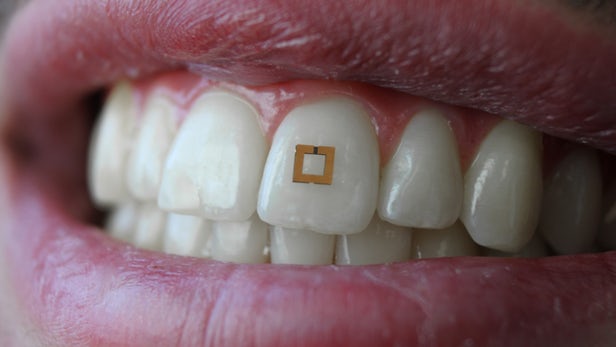You’ve gotta watch what you eat and drink … but if you need a little help doing so, a new tooth-mounted antenna-like sensor could help. Designed by scientists at Tufts University in Massachusetts, it’s currently able to track its wearer’s intake of glucose, salt and alcohol.
With a footprint of just 2 x 2 mm, the flat sensor is flexible enough to adhere to the irregular surface of a tooth. It’s made up of three sandwiched layers, consisting of two square-shaped gold rings on the outside and a layer of bioresponsive material in the middle. That middle layer absorbs the three target chemicals from within the wearer’s mouth.
When exposed to an incoming radiofrequency signal emitted by a mobile device, the sensor collects the radio waves and transmits them back, but in an altered form – depending on which and how much of the target chemicals have been absorbed by the bioactive layer, certain portions of some waves are cancelled out by the sensor instead of being transmitted.
By analyzing the spectrum and intensity of radio waves that are returned to the mobile device, an app is therefore able to determine which chemicals have been consumed, and in what quantities. Down the road, it’s possible that such sensors could detect a wider range of substances, and be applied to more than just teeth.
“In theory we can modify the bioresponsive layer in these sensors to target other chemicals – we are really limited only by our creativity,” says Prof. Fiorenzo Omenetto, corresponding author of a paper on the study. “We have extended common RFID [radiofrequency identification] technology to a sensor package that can dynamically read and transmit information on its environment, whether it is affixed to a tooth, to skin, or any other surface.”
Source












